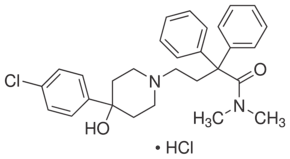All AbMole products are for research use only, cannot be used for human consumption.

Loperamide hydrochloride is an opioid-receptor agonist and acts on the μ-opioid receptors. Loperamide exhibited potent affinity and selectivity for the cloned micro (Ki = 3 nM) compared with the delta (Ki = 48 nM) and kappa (Ki = 1156 nM) human opioid receptors. Loperamide potently inhibited forskolin-stimulated cAMP accumulation (IC50 = 25 nM) in Chinese hamster ovary cells transfected with the human mu opioid receptor. Loperamide hydrochloride is also a Ca2+ channel blocker. Loperamide hydrochloride blocks broad spectrum neuronal HVA Ca2+ channels at low micromolar concentrations and at higher concentrations it reduces Ca2+ flux through NMDA receptor operated channels. Loperamide is effective for the treatment of a number of types of diarrhea. It can be used to construct animal models of functional constipation.
| Molecular Weight | 513.51 |
| Formula | C29H33ClN2O2.HCl |
| CAS Number | 34552-83-5 |
| Solubility (25°C) | DMSO 30 mg/mL |
| Storage | 4°C, dry, sealed |
| Related Animal Modeling Products |
|---|
| 3,4-Benzopyrene
3,4-Benzopyrene shows lung carcinogenicity in animal models. |
| Sodium Thioglycolate
Sodium thioglycolate acts as reducing agent and is suitable for anaerobic and microaerophilic bacterial growth. Sodium thioglycolate is a commonly used reagent for bacteriological research to maintain reducing conditions in media. Thioglycolate can also protect enzymes against inactivation by maintaining protein thiol groups in the reduced state. Thioglycolate medium is frequently used in inflammation research to elicit a neutrophil and macrophage response in vivo. |
| Vancomycin-d10 2TFA salt
Vancomycin-d10 2TFA salt |
| Acetic acid-d4
Acetic acid-d4 |
| Myosin H Chain Fragment, mouse acetate
Myosin H Chain Fragment, mouse acetate salt is a fragment of the α-Myosin heavy chain peptide. Myosin H Chain Fragment can be used to induce experimental autoimmune myocarditis (EAM) mouse model. |
All AbMole products are for research use only, cannot be used for human consumption or veterinary use. We do not provide products or services to individuals. Please comply with the intended use and do not use AbMole products for any other purpose.


Products are for research use only. Not for human use. We do not sell to patients.
© Copyright 2010-2024 AbMole BioScience. All Rights Reserved.
